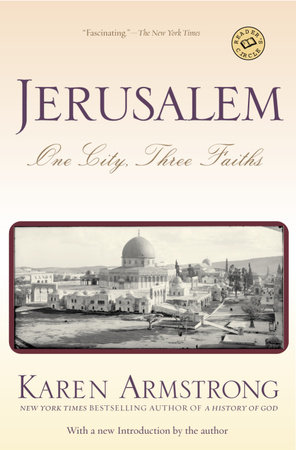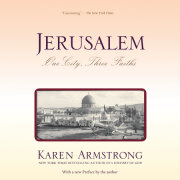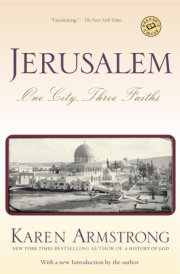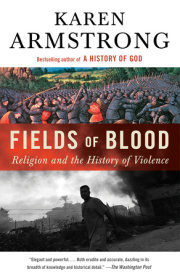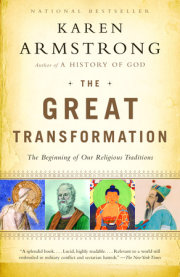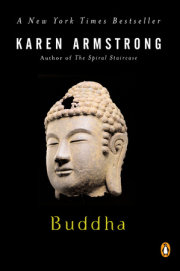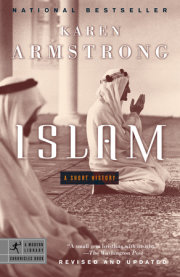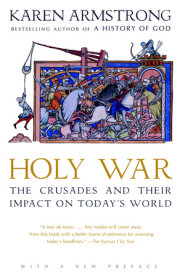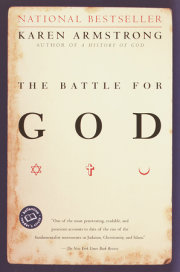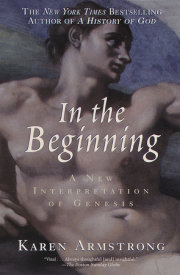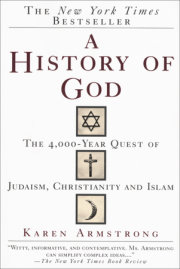1
ZION
WE KNOW NOTHING about the people who first settled in the hills and valleys that would eventually become the city of Jerusalem. In tombs on the Ophel hill, to the south of the present walls of the Old City, pottery vessels have been found which have been dated to 3200 BCE. This was the time when towns had begun to appear in other parts of Canaan, the modern Israel; in Megiddo, Jericho, Ai, Lachish, and Beth Shan, for example, archaeologists have unearthed temples, houses, workshops, streets, and water conduits. But there is as yet no conclusive evidence that urban life had begun in Jerusalem at that period. Ironically, the city which would be revered as the center of the world by millions of Jews, Christians, and Muslims was off the beaten track of ancient Canaan. Situated in the highlands, which were difficult to settle, it was outside the hub of the country. Development in the Early Bronze Age was mainly confined to the coastal plain, the fertile Jezreel Valley, and the Negev, where the Egyptians had established trade depots. Canaan was a potentially rich country: its inhabitants exported wine, oil, honey, bitumen, and grain. It also had strategic importance, linking Asia and Africa and providing a bridge between the civilizations of Egypt, Syria, Phoenicia, and Mesopotamia. But even though the springs around the Ophel hill had always attracted hunters, farmers, and temporary settlers—flints and shards have been found there dating from the Paleolithic Age—Jerusalem, as far as we know, played no part in this early florescence.
In the ancient world, civilization was always a precarious achievement. By about 2300 BCE there were virtually no cities left in Canaan. Because of either climatic change, foreign invasion, or internecine warfare, urban life disappeared. It was also a time of upheaval and instability throughout the Near East. Egypt saw the destruction of what is known as the Old Kingdom (c. 2613–2160 BCE). The Akkadian dynasty of Mesopotamia was overthrown by the Amorites, a Western Semitic people who established a capital at Babylon. Urban sites were abandoned throughout Asia Minor, and Ugarit and Byblos, on the Phoenician coast, were destroyed. For reasons that we do not understand, Syria remained unscathed and nearby towns in northern Canaan, such as Megiddo and Beth Shan, managed to survive longer than their southern neighbors. Yet in all these regions the struggle to create an ordered environment where people could lead a more secure and fulfilled life continued. New cities and new dynasties appeared and old settlements were restored. By the beginning of the second millennium the old towns of Canaan were inhabited once more.
We know very little about life in Canaan at this period. No central government developed in the country. Each town was autonomous, having its own ruler and dominating the surrounding countryside, rather as in Mesopotamia, where civilization had begun. Canaan remained an intensely regional country. There was no large-scale trade or industry, and there were such sharp differences of terrain and climate that the various districts tended to remain distinct and cut off from one another. Few people lived in the highlands, the Judaean steppes, or the Jordan Valley, where the river was not navigable and led nowhere. Communications were difficult, and people did not travel much from one part of the country to another. The main road linking Egypt and Damascus went up the coast from Gaza to Jaffa and then cut inland to avoid the swamps around Mount Carmel toward Megiddo, the Jezreel Valley, and the Sea of Galilee. Naturally these regions remained the most densely populated, and it was this area which interested the pharaohs of the Twelfth Dynasty when they began to extend their influence northward toward Syria during the twentieth and nineteenth centuries BCE. Canaan, which the Egyptians called “Retinu,” did not actually become a province of Egypt, but the pharaohs dominated the country politically and economically. Sesostris III, for example, did not hesitate to march up the coastal road to subdue local rulers who were becoming too powerful and independent. Even so, the pharaohs showed relatively little interest in other parts of Canaan, and despite the general Egyptian overlordship, towns such as Megiddo, Hazor, and Acco developed into fortified city-states. By the end of the nineteenth century, settlers had also begun to penetrate the hill country and built cities there. Shechem became the most powerful of these fortified highland towns: in area it may have been as large as thirty-seven acres, and it controlled a considerable part of the countryside. Cities, such as Hebron and Jerusalem, also developed in the southern hills.
This is the point when Jerusalem can be said to have entered history. In 1961 the British archaeologist Kathleen Kenyon discovered a wall, nearly six and a half feet thick, running along the eastern slope of the Ophel hill with a large gate near the Gihon Spring. She concluded that this town wall continued around the southern end of the hill and along the western slope. In the north it disappeared under a later city wall. Kenyon also found pottery between the wall and the rock scarp which dated to about 1800 BCE. The city was most vulnerable in the north, and later the citadel of Zion was built there; it is possible that there was also a fortress in the north of the city during the eighteenth century BCE. The walls were built quite low down the eastern slope of the Ophel, possibly to include access to an underground tunnel to the Gihon Spring.1 The British engineer Charles Warren had discovered this tunnel in 1867: it started at an opening in the rock within the city, descended obliquely, and then plunged vertically to meet the water which had been conveyed from the Gihon by means of another horizontal tunnel. Jugs and pitchers could be lowered down the shaft during a siege. Similar devices have been discovered at Megiddo, Gezer, and Gibeon. Kenyon believed that the shaft was in use during the Bronze Age, but her theory has been disputed: some doubt that the inhabitants would have had the technological skill to build such a system at this stage. But recent geological findings indicate that “Warren’s Shaft,” as it is known, is not entirely man-made; it is a natural sinkhole along a joint in the limestone, which the ancient Jerusalemites could well have modified and enlarged.
Settlers were probably attracted to the Ophel because of its proximity to the Gihon. The site also had strategic advantages, lying at the point where the foothills of the highlands give way to the Judaean desert. The Ophel could not support a large population—the city covered an area of little more than nine acres—but three steep valleys gave the settlers formidable protection: the Kidron Valley to the east, the Valley of Hinnom (or Gehenna) to the south, and the Central Valley, now largely silted up, which the Jewish historian Flavius Josephus called the Tyropoeon Valley, to the west.3 Even though the town was not one of the most important cities of Canaan, it seems to have come to the attention of the Egyptians. In 1925, sherds were bought in Luxor which, when reassembled, made up about eighty dishes and vases inscribed with an ancient hieratic script. When this was deciphered, the texts were found to contain the names of countries, towns, and rulers alleged to be the enemies of Egypt. These vases would then be smashed in a rite of sympathetic magic designed to bring about the downfall of the recalcitrant vassals. The vases have been dated to the reign of Pharaoh Sesostris III (1878–1842 BCE); they include the names of “nineteen Canaanite cities, one of which is “Rushalimum.” This is the first mention of the city in any historical record. The text also names two of its princes, Yq’rm and Shashan. In another of these so-called Execration Texts, thought to have been inscribed a century later, “Rushalimum” is cursed again, but this time the city appears to have only one ruler. From this slender shred of evidence, some scholars have inferred that during the eighteenth century, Jerusalem, like the rest of Canaan, had evolved from a tribal society with a number of chieftains to an urban settlement governed by a single king.
Here we should pause to consider the name of the city. It seems to have incorporated the name of the Syrian god Shalem, who was identified with the setting sun or the evening star. Canaan may have been dominated politically by Egypt, but in cultural and religious affairs the chief influence was Syria. In Hazor, Megiddo, and Shechem, temples of this period have been unearthed that have clearly been built on a Syrian model. They are constructed according to the same basic plan as the king’s palace, underlining the fact that all rule was seen to derive from the gods. The laity were forbidden to enter the Hekhal, or cult hall, just as they were denied access to the king’s presence. They could glimpse the god’s effigy, which was placed in a niche at the end of the hall, from the courtyard, through the open doors of the Hekhal. No Bronze Age temple has been unearthed in Jerusalem, but the city’s name shows that the inhabitants were also open to Syrian religion. The names of the Jerusalem princes in the Execration Texts indicate that, like the people of Syria, the Jerusalemites were of Western Semitic origin and shared the same worldview.
Copyright © 2011 by Karen Armstrong. All rights reserved. No part of this excerpt may be reproduced or reprinted without permission in writing from the publisher.

